
James Brooke (29th April 1803 – 11 June 1868)
The picture is from a painting by Sir Francis Grant in 1847
Sarawak, the name brings forth ideas of head hunters and ‘daring do’ from comics that I read in the 1950’s.
Little did I know that one day I would sail up the Sarawak River to the town of Kuching on the island of Borneo.
Sarawak had been James Brooke’s & his descendants fiefdom since about 1841 – until . .
In April 1942 the Japanese captured Sarawak, and for three years they ran the place as part of the Empire of Japan.
The Japanese surrender to the Australians in 1945, and Sarawak became a British Colony.
In May 1961 the PM of Malaysia, Tunku Abdul Rahman, put forward a plan for a greater Malaysia, which included Singapore, Sarawak, Sabah & Brunei. In 1962 eighty percent of the population of Sarawak & Sabah voted to join Malaya to create Malaysia, along with Singapore.
Indonesia and the Philippines didn’t like the creation of Malaysia. So Indonesia encouraged discontent with the communists of Sarawak and trained them in military tactics, and also supplied armed ‘volunteers’ to causes problems for Sarawak and the newly created country of Malaysia.
The fighting began in 1963 with infiltration forces from Indonesia in to Sarawak. By this time the British were involved in support of Malaysia, who had only gained independence from Britain a few years earlier in 1957.
Later Australia & New Zealand became involved in support of Malaysia.
Knowing little of the details that I know now, I flew in to Singapore to join LST (Landing ship tank) Frederick Clover in April 1966. The company, British India Steam Navigation Co, held the contract to man various LSTs based in Singapore, Malta, Aden etc and I’d drawn the straw for Frederick Clover, based in Singapore.
If you wish to see other photographs of the LST and why I fired a machine gun click on the highlighted letters.
 Frederick Clover, alongside in Singapore, her bows open to accept military cargo for Borneo. The photo is old and not very clear.
Frederick Clover, alongside in Singapore, her bows open to accept military cargo for Borneo. The photo is old and not very clear.
 As you see she was an old ship, built in 1945. The captain’s chair had to be lashed down to make sure we didn’t lose it in a strong wind. My hair isn’t moving because our top speed was 10 knots . . . .
As you see she was an old ship, built in 1945. The captain’s chair had to be lashed down to make sure we didn’t lose it in a strong wind. My hair isn’t moving because our top speed was 10 knots . . . .
 At least we had a compass. Although we could have found our way to Borneo using the echo sounder by following the empty beer cans from our previous trips. At that time being Green meant you were sea sick, not environmentally aware.
At least we had a compass. Although we could have found our way to Borneo using the echo sounder by following the empty beer cans from our previous trips. At that time being Green meant you were sea sick, not environmentally aware.
 While we were alongside in Kuching the ‘Auby’ moored astern of us. She was to take a Gurkha regiment back to Singapore. The Auby was a cargo ship of about 1700 tons , with facilities for a few passengers in the for’d accommodation. I can only assume the soldiers traveled as ‘deck cargo’. The Auby carried about 31,000 troops in and out of Singapore during the ‘confrontation’. The picture is not all that clear but the troops can be seen formed up on the quay.
While we were alongside in Kuching the ‘Auby’ moored astern of us. She was to take a Gurkha regiment back to Singapore. The Auby was a cargo ship of about 1700 tons , with facilities for a few passengers in the for’d accommodation. I can only assume the soldiers traveled as ‘deck cargo’. The Auby carried about 31,000 troops in and out of Singapore during the ‘confrontation’. The picture is not all that clear but the troops can be seen formed up on the quay.
In 2011, Maureen & I attended a reunion in Singapore of cadets from HMS Conway Training College, so after the reunion I thought it would be an ideal time to take Maureen to Kuching and a spot of ‘I remember when’ for me.

While in Kuching we did a river cruise in a small boat, which allowed me to photograph the quay, (see above), which I think is the same one in the photographs showing the Gurkha troops.
 Our boatman and his boat that we used.
Our boatman and his boat that we used.
We stayed at the Pullman Hotel, which overlooked the town.

 This one shows the Sarawak River
This one shows the Sarawak River
Kuching is also known as Cat City – there are a number of anecdotes as to why Kuching got its name. It used to be called Sarawak until James Brooke arrived by sea and asked his guide the name of the place, while pointing to the small town. The local guide thinking that James was pointing at a cat, answered ‘Kuching’, which is the Malay word for cat i.e ‘kucing’. Against this story being true is that the local Malays who live in Kuching call a cat a ‘pusak’
Another story is that the town is named after a river called Sungai Kuching, which means Cat River. Another idea is that it is named after mata kucing, which is a fruit grown in Malaysia, Indonesia and the northern parts of Australia. The name means Cats Eye.

The mata kucing fruit looks like a lychee.
So with a name like ‘Cat’, Kuching turned itself in to a tourist attraction by becoming the Cat City.

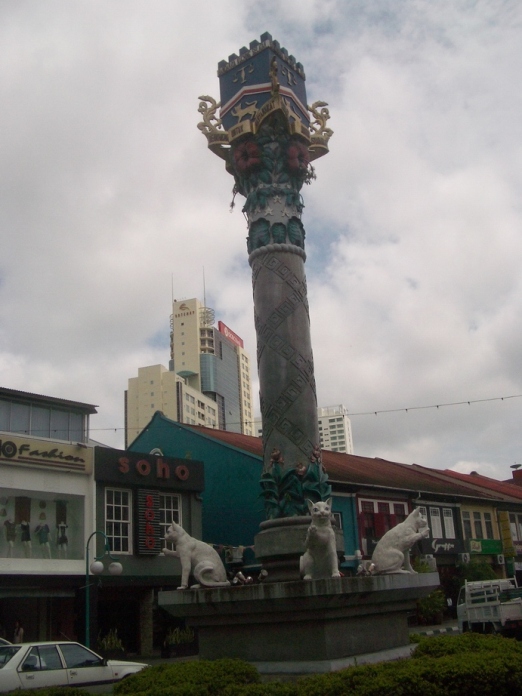

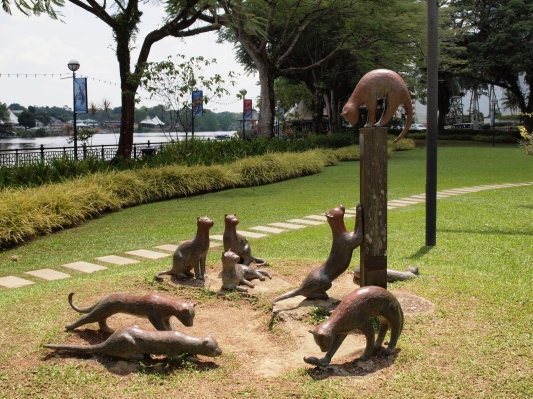 The above cat statues are outside our favourite restaurant.
The above cat statues are outside our favourite restaurant.
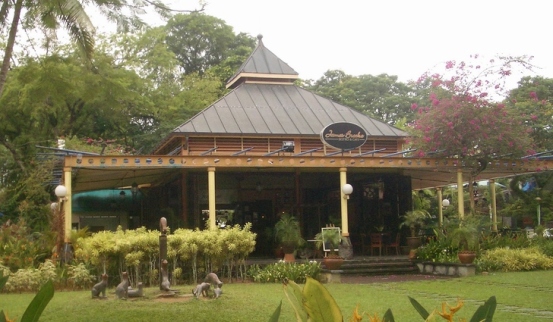 The James Brooke on the water front.
The James Brooke on the water front.
 It is also a bar, and you do not have to order food.
It is also a bar, and you do not have to order food.


Of course we ordered lunch – Laksa – beautiful, and for me a cold beer helped it down.

The following year we returned to Kuching with two other couples, and it wasn’t a hardship to revisit many places again.
During one evening in the James Brooke restaurant I overheard an accent that I recognised – it was a Liverpool accent. The four men having their evening meal worked as contractors for an aircraft company and flew around the world fixing problems. Because Maureen originated in Liverpool it didn’t take long for us to get chatting.
I asked one fellow where he lived on Merseyside and he told me Birkenhead. I mentioned that I came from Lower Tranmere in Birkenhead, and we then swapped details of the exact area. It turned out that he knew where my childhood street was, because he lived quite close.
The following night we met him again and he said that he had phoned his father in the UK, who was retired and still living in Lower Tranmere, and told him of meeting me. It turns out that his father was our milkman, and he used to deliver milk to my home when I was a child. Talk about a small world.
During my remember when holiday I couldn’t understand why the river never dropped as the tide turned.
 Dressed overall for the last voyage to Singapore before the ship would be sold.
Dressed overall for the last voyage to Singapore before the ship would be sold.
Generous meals, as the guest of various army units, helped to break the boredom of being in an out of the way port. We were not there to make a profit through trade, but in support of our own troops, a huge difference.
When we heard that the ship was to be sold on our return to Singapore, we decided to have a farewell dinner along with a number of army officers. Tables were booked at the local Chinese restaurant and all the ship’s officers left the ship, leaving just a watchman. It was a quiet night with little river traffic so we felt a single watchman was enough. The majority of the crew were allowed shore leave, because they would soon be out of work once we reached Singapore.
The evening went well until we returned to the ship and found her lying at a strange angle. What had happened was that the tide had gone out and the river had dropped causing the ship to settle in the mud. Being flat bottomed she would have settled upright if the watchman had slackened off the mooring lines – he’d not done so, and Frederick Clover was lying with a very large list away from the wharf – her mooring lines were bar tight with the strain.
There was little that we could do but wait for the tide to turn and raise her back to normal, which fortunately is what happened.
So during our holiday I asked why I hadn’t seen the river drop as the tide went out – it was all down to a barrage that had been built at the mouth of the river in the late 90’s, which controlled the flow of the river. The gates would be opened each Friday afternoon to flush out any rubbish etc.

They do have the facility to allow small fishing boats to enter the river – which means that they must have a lock system.
At least I wasn’t going mad, because I was sure that the river would drop as the tide changed.
 If you are interested in Sarawak and the island of Borneo, but don’t wish to read a great tome, try the above book, which is an easy and interesting read.
If you are interested in Sarawak and the island of Borneo, but don’t wish to read a great tome, try the above book, which is an easy and interesting read.
The wife of the third Rajah, Sylvia Brooke, who wrote her own autobiography in 1970, also wrote a synopsis of the life of James Brooke, which was bought by Warner Brothers film studio.
Errol Flynn wanted to play James Brooke, but in the script that he wrote, after reading the synopsis, he had James Brooke arriving in Borneo with a young woman dressed as a boy.
Sylvia Brooke refused to allow Flynn’s story to go any further, because there wasn’t any ‘love interest’ when Brooke arrived in Borneo. According to Sylvia Brooke James Brooke was the first white man to set foot in Borneo – which I find hard to believe.
Finally when Somerset Maugham visited Sarawak, it was suggested that James Brooke’s life would make a good film, but Somerset Maugham said, no it wouldn’t, because there wasn’t any love interest.
James Brooke’s life was full of love, he inspired love and felt love, so perhaps it is time for the right actor to take up the challenge and recreate The White Rajah.







 We were alongside for two days, one hundred and eleven years after the first BI ship, the Cape of Good Hope, called in to Rangoon.
We were alongside for two days, one hundred and eleven years after the first BI ship, the Cape of Good Hope, called in to Rangoon. We stayed at the Traders Hotel – the white building on the right. On the left is Scott’s Market, now called Bogyoke Market but everyone we spoke to referred to it as Scott’s.
We stayed at the Traders Hotel – the white building on the right. On the left is Scott’s Market, now called Bogyoke Market but everyone we spoke to referred to it as Scott’s.
 Inside the market – gold, jade, silver what ever you wished. Ground floor.
Inside the market – gold, jade, silver what ever you wished. Ground floor.

 The tea room in the main foyer (ground level not the Club Floor).
The tea room in the main foyer (ground level not the Club Floor).


 I considered that all I had to do was stamp on his toe and I would be able to rob the place. EXCEPT that when I walked in I saw the rear wall behind the tellers was a solid wall of money, and at the exchange rate that we were offered, to make a robbery worth while, I’d need a forklift to carry more than a few thousand dollars worth of Kyat!
I considered that all I had to do was stamp on his toe and I would be able to rob the place. EXCEPT that when I walked in I saw the rear wall behind the tellers was a solid wall of money, and at the exchange rate that we were offered, to make a robbery worth while, I’d need a forklift to carry more than a few thousand dollars worth of Kyat! When I took the above picture I had my back to the bank’s main doorway, so attempting a fast get away, using a fork lift, didn’t seem all that practical.
When I took the above picture I had my back to the bank’s main doorway, so attempting a fast get away, using a fork lift, didn’t seem all that practical. Small street always attracted me – you didn’t know what you’d find.
Small street always attracted me – you didn’t know what you’d find.


 In 2012 we had a drink in this bar, and sat at the far end – the staff were indifferent to us, and the service extremely slow, I only hope they have lifted their game since the refurbishment.
In 2012 we had a drink in this bar, and sat at the far end – the staff were indifferent to us, and the service extremely slow, I only hope they have lifted their game since the refurbishment.

 The ferry terminal and the ferry on the river approaching.
The ferry terminal and the ferry on the river approaching.

 Looking back at the ferry terminal
Looking back at the ferry terminal

 Approaching the other side of the river.
Approaching the other side of the river.

 A touch of the old Raj . . .for Rangoon railway station.
A touch of the old Raj . . .for Rangoon railway station.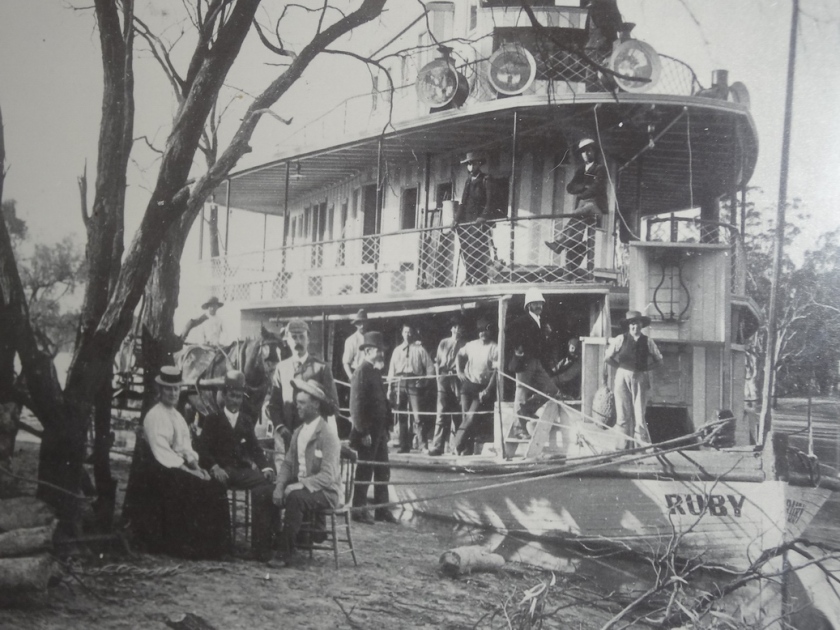
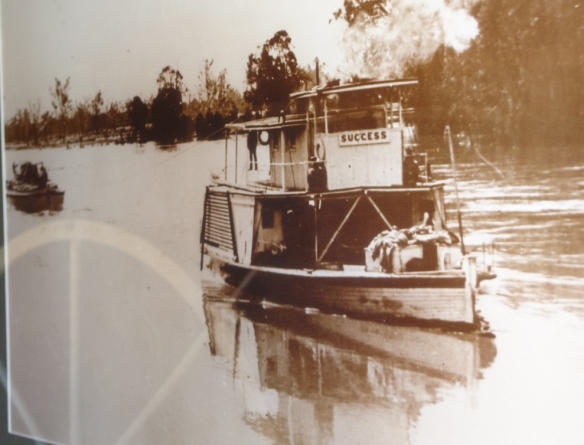
 Of course when we did our road trip a year or so ago I wanted to see, and cruise on a river boat on the Murray River.
Of course when we did our road trip a year or so ago I wanted to see, and cruise on a river boat on the Murray River. We bought a ticket on the Rothbury – the Master was a fund of stories and history of the river.
We bought a ticket on the Rothbury – the Master was a fund of stories and history of the river. Wheelhouse – as we steamed along the children onboard where given the chance to steer.
Wheelhouse – as we steamed along the children onboard where given the chance to steer.


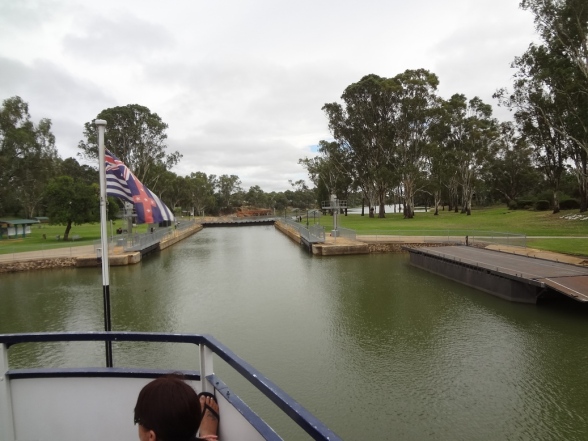 Approaching the lock – the flag is the flag of the River Murray.
Approaching the lock – the flag is the flag of the River Murray.

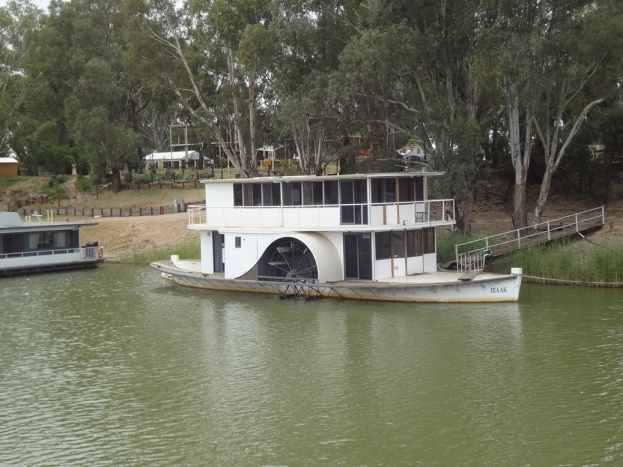
 or you can hire one for the family holiday.
or you can hire one for the family holiday.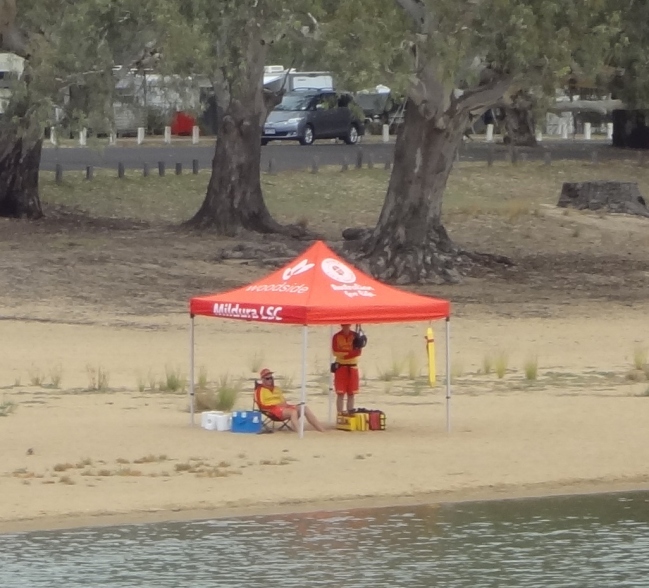 I found this funny – two uniformed surf lifesavers who are about 900 km from the sea via the Murray River.
I found this funny – two uniformed surf lifesavers who are about 900 km from the sea via the Murray River. Swim between the flags!
Swim between the flags!
 The only sound on the river was the sound of our paddles- it was very relaxing and peaceful.
The only sound on the river was the sound of our paddles- it was very relaxing and peaceful.


 I had to take a picture of this car as Maureen & I made our way to a restaurant after leaving the paddle steamer. I am not ‘in to’ cars, because for me they get me from A to B and that’s it – but the registration plate caught my eye – it just said – FP . . . . . .make what you will out of the registration . . .
I had to take a picture of this car as Maureen & I made our way to a restaurant after leaving the paddle steamer. I am not ‘in to’ cars, because for me they get me from A to B and that’s it – but the registration plate caught my eye – it just said – FP . . . . . .make what you will out of the registration . . .






 A picture is worth a thousand words . . . as we enter Milford Sound.
A picture is worth a thousand words . . . as we enter Milford Sound.




 Tourist boats approaching a waterfall.
Tourist boats approaching a waterfall.


 So much for summer you can see the snow on the hills (top left).
So much for summer you can see the snow on the hills (top left).



 As we turned Milford came in to view.
As we turned Milford came in to view.

 As we steamed out the sky started to clear.
As we steamed out the sky started to clear.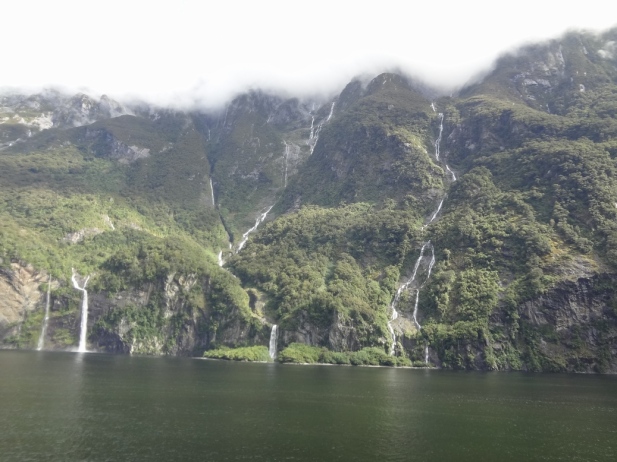




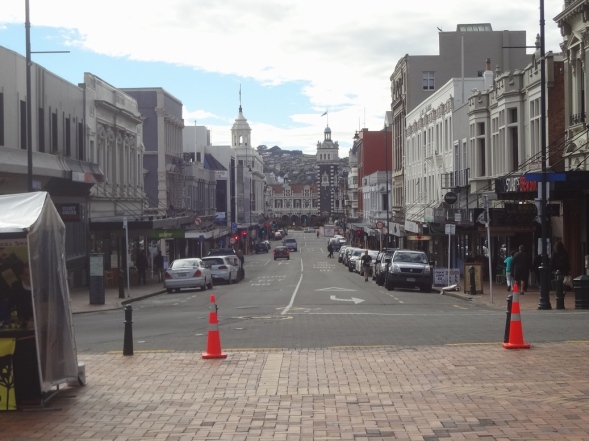 Part of the main shopping street taken from the city centre market area – the Octagon Reserve.
Part of the main shopping street taken from the city centre market area – the Octagon Reserve. The market was not a food market, but general item market and at 9.30 am it had not yet begun to trade properly. There were a few stalls operating, but we were more interested in the various local sites than shopping.
The market was not a food market, but general item market and at 9.30 am it had not yet begun to trade properly. There were a few stalls operating, but we were more interested in the various local sites than shopping. Regent Theater built in 1928, it can seat 2000 people. To help to keep it going, after the refurbishment in 2010, the management have an annual second hand book sale, which has grown to be the largest secondhand book sale in NZ, and some consider even in the southern hemisphere. The sale raises over $100,000 a year towards the upkeep of the theater. The books sell for about $1 each, having been donated for free by the residents of the city.
Regent Theater built in 1928, it can seat 2000 people. To help to keep it going, after the refurbishment in 2010, the management have an annual second hand book sale, which has grown to be the largest secondhand book sale in NZ, and some consider even in the southern hemisphere. The sale raises over $100,000 a year towards the upkeep of the theater. The books sell for about $1 each, having been donated for free by the residents of the city.
 When cruise ships are in port the cathedral offers free organ recitals during the day.
When cruise ships are in port the cathedral offers free organ recitals during the day.
 Picture from the internet my own effort was very poor.
Picture from the internet my own effort was very poor. Dunedin and Edinburgh have been ‘twined’ since 1974.
Dunedin and Edinburgh have been ‘twined’ since 1974. After we’d wandered around on our own we joined the others for the tour of Dunedin and the surrounding area. The above picture is Otago Boys High school, founded in 1863 and is New Zealand’s oldest boys’ secondary school.
After we’d wandered around on our own we joined the others for the tour of Dunedin and the surrounding area. The above picture is Otago Boys High school, founded in 1863 and is New Zealand’s oldest boys’ secondary school. Baldwin Street, which is listed as the steepest residential street in the world.
Baldwin Street, which is listed as the steepest residential street in the world. Jaffas from the internet
Jaffas from the internet
 Remember when railway stations were a work of art?
Remember when railway stations were a work of art? I suppose they would have had the same feeling that one gets today at an airport – but why do I prefer railway stations? For me, a railway station is far more romantic, think
I suppose they would have had the same feeling that one gets today at an airport – but why do I prefer railway stations? For me, a railway station is far more romantic, think  The Silver Fern about to depart – will the lady with the blue bag make it?
The Silver Fern about to depart – will the lady with the blue bag make it?
 The feel of solidarity – stained glass windows – very church like.
The feel of solidarity – stained glass windows – very church like.

 Swimming beach, but I wouldn’t fancy a swim at this beach considering there is little between it and the Antarctic. Perhaps if I wore a wet suite I’d brave the water.
Swimming beach, but I wouldn’t fancy a swim at this beach considering there is little between it and the Antarctic. Perhaps if I wore a wet suite I’d brave the water. We were still in the outer suburbs, when across the road the local sheep didn’t seem to mind our yellow bus. Dunedin can be seen across the hills.
We were still in the outer suburbs, when across the road the local sheep didn’t seem to mind our yellow bus. Dunedin can be seen across the hills. An unusual memorial to those who died in the Christchurch earthquake. 185 chairs all shapes and sizes painted white to remember the victims of the 2011. They stand on the ground where once stood a church – the church was destroyed by the earthquake.
An unusual memorial to those who died in the Christchurch earthquake. 185 chairs all shapes and sizes painted white to remember the victims of the 2011. They stand on the ground where once stood a church – the church was destroyed by the earthquake.
 The other side of the cardboard cathedral. It can seat 700 hundred people. The ‘A’ frame incorporates eighty six cardboard tubes each tube weighing 500 kilos. The picture is slightly off center because I took it from a moving vehicle, and we couldn’t stop.
The other side of the cardboard cathedral. It can seat 700 hundred people. The ‘A’ frame incorporates eighty six cardboard tubes each tube weighing 500 kilos. The picture is slightly off center because I took it from a moving vehicle, and we couldn’t stop. This picture was taken from the internet – the original church on this site was demolished because of the amount of damage to it during the 2011 earthquake.
This picture was taken from the internet – the original church on this site was demolished because of the amount of damage to it during the 2011 earthquake.

 Nobody was able to tell me if it would be repaired or demolished.
Nobody was able to tell me if it would be repaired or demolished.
 Yet again, others were being held up with girders.
Yet again, others were being held up with girders.


 Christchurch was far from miserable. Everyone we saw seemed happy and the place had plenty of spending tourists .I did hear that the council wanted to remove the sea container emergency shopping area, but the area has become a tourist attraction as a symbol of Christchurch’s fortitude.
Christchurch was far from miserable. Everyone we saw seemed happy and the place had plenty of spending tourists .I did hear that the council wanted to remove the sea container emergency shopping area, but the area has become a tourist attraction as a symbol of Christchurch’s fortitude.
 It was a beautiful day for walking across the River Avon – very English.
It was a beautiful day for walking across the River Avon – very English. You could feed the ducks or just sit quiet under the trees. The river flowed gently.
You could feed the ducks or just sit quiet under the trees. The river flowed gently.


 We’d crossed the hills and were now down on the flat driving to Akaroa and our tender boat. You can just see the two ships anchored.
We’d crossed the hills and were now down on the flat driving to Akaroa and our tender boat. You can just see the two ships anchored.



 Street names have a mix of English and French.
Street names have a mix of English and French. French baker and the French flag can bee seen flying over various buildings.
French baker and the French flag can bee seen flying over various buildings.
 Dawn Princess on the left and the Seabourne Encore on the right.
Dawn Princess on the left and the Seabourne Encore on the right.

 On leaving Akaroa for Lyttelton, before making our way to Christchurch, the route took us around the furthest point that the harbor stretched inland. As you see the tide was ‘out’.
On leaving Akaroa for Lyttelton, before making our way to Christchurch, the route took us around the furthest point that the harbor stretched inland. As you see the tide was ‘out’. A short time later we began the climb to cross the local hills that surrounded the harbour.
A short time later we began the climb to cross the local hills that surrounded the harbour.
 Taken from the bus as we climbed – the picture is looking back at Akaroa harbor.
Taken from the bus as we climbed – the picture is looking back at Akaroa harbor.








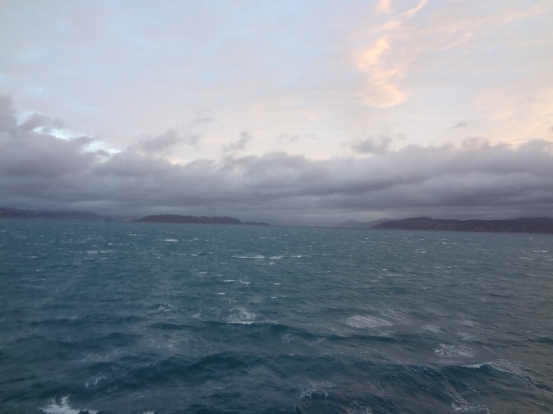 We are aiming for the gap.
We are aiming for the gap. Picture from the internet.
Picture from the internet. It was an interesting place because the terminus for the cable car was also a museum.
It was an interesting place because the terminus for the cable car was also a museum. They had old railcars on display where the passenger sat on the outside (as well as the inside) – health and safety hadn’t been invented.
They had old railcars on display where the passenger sat on the outside (as well as the inside) – health and safety hadn’t been invented.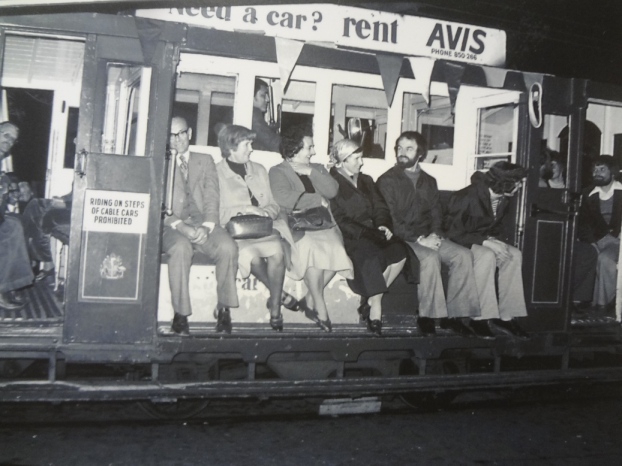

 Maureen & our guide. Note the flags, which belong to the Royal Navy, the New Zealand Merchant Navy and the US Marines (second division), which were all stationed in Wellington during WW2.
Maureen & our guide. Note the flags, which belong to the Royal Navy, the New Zealand Merchant Navy and the US Marines (second division), which were all stationed in Wellington during WW2.


 New Zealand Parliament House- the building on the left is known locally as The Beehive. It houses the offices of the PM and various ministers as well as support staff.
New Zealand Parliament House- the building on the left is known locally as The Beehive. It houses the offices of the PM and various ministers as well as support staff.
 Parliamentary Library – to the left of this building is the Parliament Building and further left the Beehive.
Parliamentary Library – to the left of this building is the Parliament Building and further left the Beehive.
 and this is a Wellington summer . . . .at least I was able to wear shorts . . .
and this is a Wellington summer . . . .at least I was able to wear shorts . . .
 Wahine, just under 9,000gt
Wahine, just under 9,000gt

 Some of the lucky ones were helped by local people and the police.
Some of the lucky ones were helped by local people and the police.

 I had the fish, which was very nice, and it didn’t taste of chocolate.
I had the fish, which was very nice, and it didn’t taste of chocolate. As we left the restaurant I saw two ships alongside – ours was the one on the left and the one on the right was –
As we left the restaurant I saw two ships alongside – ours was the one on the left and the one on the right was – 



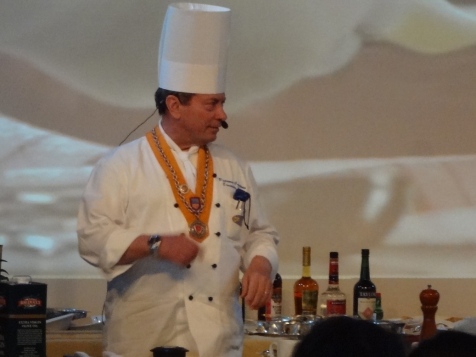

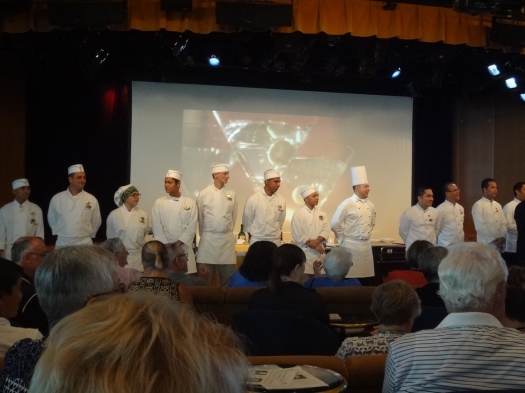






 As we moved through the galley the creative art of some of the staff came to light. All made from fruit and vegetables.
As we moved through the galley the creative art of some of the staff came to light. All made from fruit and vegetables.







